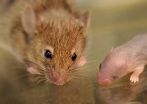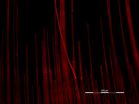(Press-News.org) DURHAM, N.C. – All parents know the infant milestones: turning over, learning to crawl, standing, and taking that first unassisted step. Achieving each accomplishment presumably requires the formation of new connections among subsets of the billions of nerve cells in the infant's brain. But how, when and where those connections form has been a mystery.
Now researchers at Duke Medicine have begun to find answers. In a study reported Jan. 23, 2013, in the scientific journal Neuron, the research team describes the entire network of brain cells that are connected to specific motor neurons controlling whisker muscles in newborn mice.
A better understanding of such motor control circuits could help inform how human brains develop, potentially leading to new ways of restoring movement in people who suffer paralysis from brain injuries, or to the development of better prosthetics for limb replacement.
"Whiskers to mice are like fingers to humans, in that both are moving touch sensors," said lead investigator Fan Wang, PhD, associate professor of cell biology and member of the Duke Institute for Brain Sciences. "Understanding how the mouse's brain controls whisker movements may tell us about neural control of finger movements in people."
Mice are active at night, so they rely heavily on whiskers to detect and discriminate objects in the dark, brushing their whiskers against objects in a rhythmic back-and-forth sweeping pattern referred to as "whisking". But this whisking behavior does not appear until about two weeks after birth, when young mice start to explore the world outside their nest.
To learn how motor control of whiskers takes place, Wang and postdoctoral fellow Jun Takatoh used a new technique that takes advantage of the rabies virus' ability to spread through connected nerve cells. A disabled form of the virus used to vaccinate pets was created with the ability to express a fluorescent protein. The researchers were able to trace its path through a network of brain cells directly connected to the motor neurons controlling whisker movement.
"The precision of this mapping method allowed us to ask a key question, namely are parts of the whisker motor control circuitry not yet connected in newborn mice, and are such missing links added later to enable whisking?" Wang said.
By taking a series of pictures in the fluorescently labeled brains during the first two weeks after birth, the research team chronicled the developing circuits before and after mice start whisking.
"When we traced the circuit it was stunning in the sense that we didn't realize there are so many pools of neurons located throughout the brainstem that are connected to whisker motor neurons," said Wang. "It's remarkable that a single motor neuron receives so many inputs, and somehow is able to integrate them."
At the same time whisking movements emerge, motor neurons receive a new set of inputs from a region of the brainstem called the LPGi. A single LPGi neuron is connected to motor neurons on both sides of the face, putting them in perfect position to synchronize the movements of left and right whiskers.
To learn more about the new circuit formed between LPGi and motor neurons, Wang and Takatoh drew on the expertise of Duke colleague Richard Mooney, PhD, professor of neurobiology, and his student Anders Nelson. Together, the researchers were able to record the labeled neurons and found the LPGi neurons communicate with motor neurons using glutamate, the main neurotransmitter that stimulates the brain. They further discovered that LPGi neurons receive direct inputs from the motor cortex.
"This makes sense because exploratory whisking is a voluntary movement under control of the motor cortex," Wang said. "Excitatory input is needed for initiating such movements, and LPGi may be critical for relaying signals from the motor cortex to whisker motor neurons."
The researchers will next explore the connectivity by using genetic, viral and optical tools to see what happens when certain components of the circuits are activated or silenced during various motor tasks.
INFORMATION:
In addition to Wang, Takatoh, Mooney and Nelson at Duke, study authors include Xiang Zhou of the University of Chicago; Michael D. Ehlers of Pfizer Inc. R&D; M. McLean Bolton of the Max Planck Institute; and Benjamin R. Arenkiel of Baylor College of Medicine.
The research was supported by grants from the National Institutes of Health (DA028302, DE19440, NS079929) and by the Duke Institute for Brain Sciences.
Image: A mouse pup learns to use its whiskers to sense objects at about the second week of life. The nerve connections that enable this activity are helping researchers at Duke Medicine learn how human brains develop and function.
New brain circuit sheds light on development of voluntary movements
2013-01-23
ELSE PRESS RELEASES FROM THIS DATE:
Whole-exome sequencing identifies inherited mutations in autism
2013-01-23
Boston, Mass. - While autism clearly runs in some families, few inherited genetic causes have been found. A major reason is that these causes are so varied that it's hard to find enough people with a given mutation to establish a clear pattern. Researchers at Boston Children's Hospital have pinpointed several inherited mutations—among the first to be identified—through an unusual approach: using whole-exome sequencing to study large Middle Eastern families with autism.
The study, published in the January 23 issue of the journal Neuron, also found evidence for some of ...
Setting the dark on fire
2013-01-23
In space, dense clouds of cosmic gas and dust are the birthplaces of new stars. In visible light, this dust is dark and obscuring, hiding the stars behind it. So much so that, when astronomer William Herschel observed one such cloud in the constellation of Scorpius in 1774, he thought it was a region empty of stars and is said to have exclaimed, "Truly there is a hole in the sky here!" [1]
In order to better understand star formation, astronomers need telescopes that can observe at longer wavelengths, such as the submillimetre range, in which the dark dust grains shine ...
Researchers design a new imaging technique for identifying the age and sex of a corpse
2013-01-23
Researchers at the University of Granada, Spain, have designed a new computing system that determines the age and sex of a corpse with a reliability of 95%. This system is based on free software called Image and a free DICOM displayer called K-Pacs. This state-of-the-art system is very different from the traditional macroscopy systems used to evaluate the osteoarticular features of a corpse, and it is much faster and user-friendly.
The author of this study is Manuel López Alcaraz, a researcher at the Forensic Anthropology Laboratory of the University of Granada, in collaboration ...
Astrocytes identified as target for new depression therapy
2013-01-23
BOSTON (January 23, 2013) — Neuroscience researchers from Tufts University have found that our star-shaped brain cells, called astrocytes, may be responsible for the rapid improvement in mood in depressed patients after acute sleep deprivation. This in vivo study, published in the current issue of Translational Psychiatry, identified how astrocytes regulate a neurotransmitter involved in sleep. The researchers report that the findings may help lead to the development of effective and fast-acting drugs to treat depression, particularly in psychiatric emergencies.
Drugs ...
Type 1 diabetes in urban children skyrockets, increasing by 70 percent in children under age 5
2013-01-23
Over the past two decades, the incidence of type 1 diabetes in very young children under age 5 has increased by 70 percent in the city of Philadelphia, according to research from a University of Pennsylvania School of Nursing researcher who currently maintains the only US registry of diabetes in children that has collected data continuously since 1985.
In a far-reaching study in the current issue of Diabetes Care, researchers led by nursing professor Terri H. Lipman, PhD, RN found that the overall incidence of Type 1 diabetes in children in Philadelphia has increased ...
Forcing choice may hamper decision-making, study finds
2013-01-23
Constraining choice isn't necessarily a good thing when it comes to managers' problem-solving, according to a new Canadian study.
Managers tend to pick higher-risk options when forced to choose between competing alternatives to complex situations, according to researchers from the University of Guelph and University of Waterloo whose study was published recently in the Journal of Business Ethics.
But when they're not forced to choose, managers tend to reflect more and solve problems with fewer negative consequences, says the study.
"One of the most powerful tools ...
NIH-developed candidate dengue vaccine shows promise in early-stage trial
2013-01-23
A candidate dengue vaccine developed by scientists at the National Institutes of Health (NIH) has been found to be safe and to stimulate a strong immune response in most vaccine recipients, according to results from an early-stage clinical trial sponsored by the National Institute of Allergy and Infectious Diseases (NIAID), part of the NIH. The trial results were published online on January 17 in the Journal of Infectious Diseases.
Dengue fever, prevalent in many tropical and subtropical regions of the world, is caused by any of four related viruses—DENV-1, DENV-2, DENV-3 ...
Self-assembling silica microwires may herald new generation of integrated optical devices
2013-01-23
WASHINGTON, Jan. 23, 2013—Silica microwires are the tiny and as-yet underutilized cousins of optical fibers. If precisely manufactured, however, these hair-like slivers of silica could enable applications and technology not currently possible with comparatively bulky optical fiber. By carefully controlling the shape of water droplets with an ultraviolet laser, a team of researchers from Australia and France has found a way to coax silica nanoparticles to self-assemble into much more highly uniform silica wires.
The international team describes their novel manufacturing ...
Parents numb to misuse of narcotic pain meds by youth, new poll shows
2013-01-23
ANN ARBOR, Mich. – Despite data on rising rates of abuse and overdoses of narcotic pain medicines across all age groups, in a new poll from the University of Michigan, most parents said they are not very concerned about misuse of these medicines by children and teens. .
In addition, parent support was lukewarm for policies that would discourage abuse of drugs like Vicodin or Oxycontin, according to the most recent University of Michigan Mott Children's Hospital National Poll on Children's Health.
Overall, 35% of parents said they are very concerned about misuse of ...
Experts believe plain packaging of tobacco products would cut smoking
2013-01-23
Experts believe that plain packaging of tobacco products would cut smoking, a new study has found. Tobacco control experts from around the world estimate that two years after the introduction of generic packaging the number of adult smokers would be reduced by one percentage point (in the UK - from 21 to 20%*), and the percentage of children trying smoking would be reduced by three percentage points (in the UK - from 27 to 24%*). The Cambridge research was published today in the journal BMC Public Health.
Because Australia, the first country to implement plain packaging, ...


